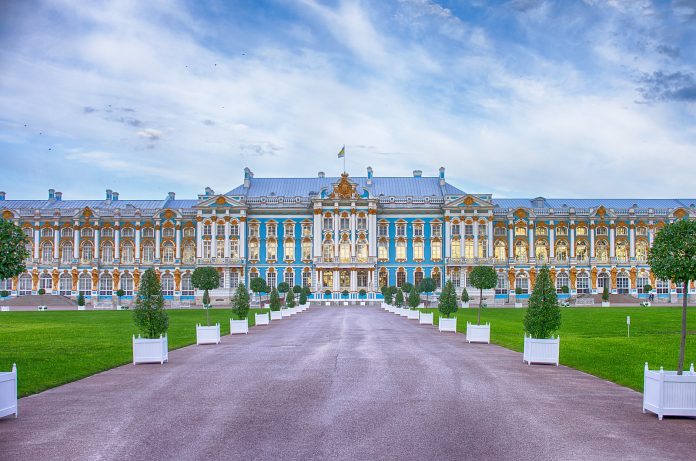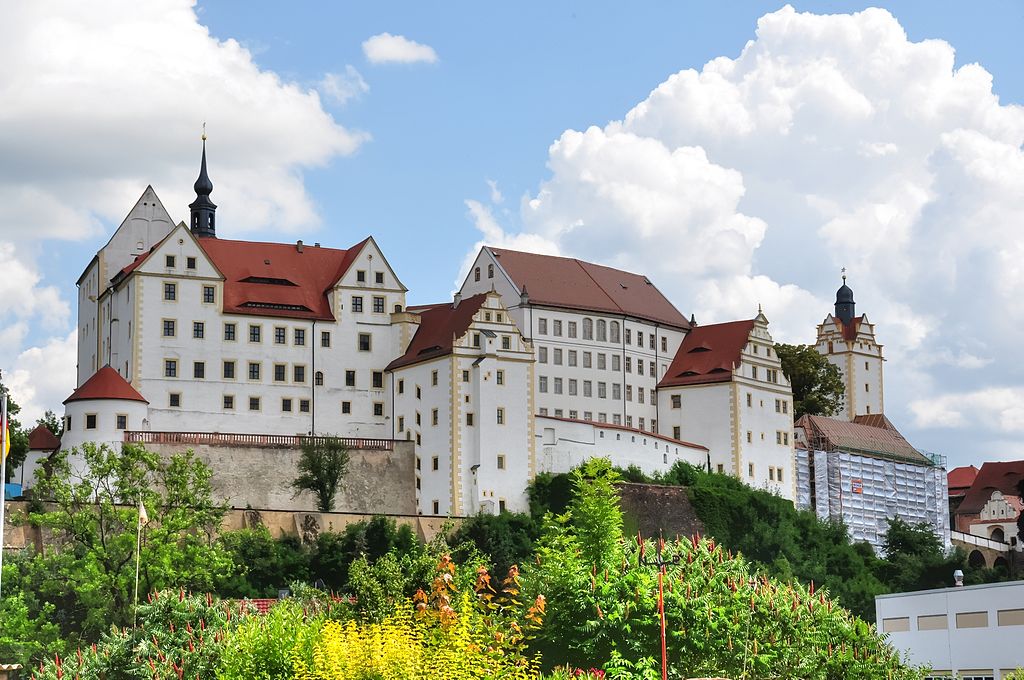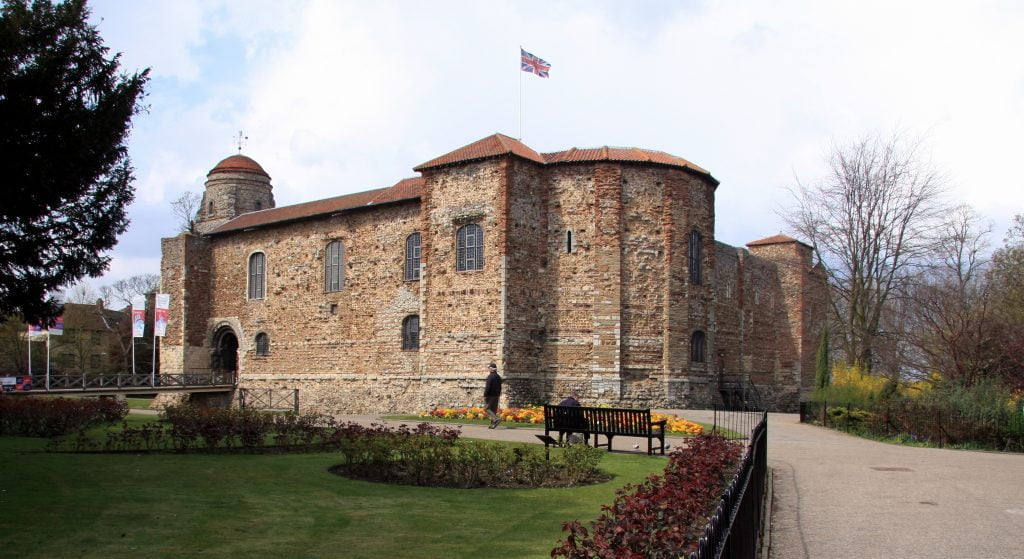Taking a trip through Catherine Palace feels like stepping into the world of 18th-century tsardom. Just imagine walking through some of the finest examples of Russian Renaissance period architecture and enjoying the uniqueness of that era in all its glory. Catherine Palace is the epitome of class and luxury – a depiction of the peak of the Russian Empire. Together with Pushkin’s scenic views and breezy weather, this makes for an excellent tourist destination! Let’s take a look at Catherine Palace and everything you need to know about it:
Table of Contents
The mural on the ceiling of the Courtiers-in-Attending Dining Room is based on ancient Greek mythological concepts including that of Helios, the sun god, and Eos, the goddess of sunrise.
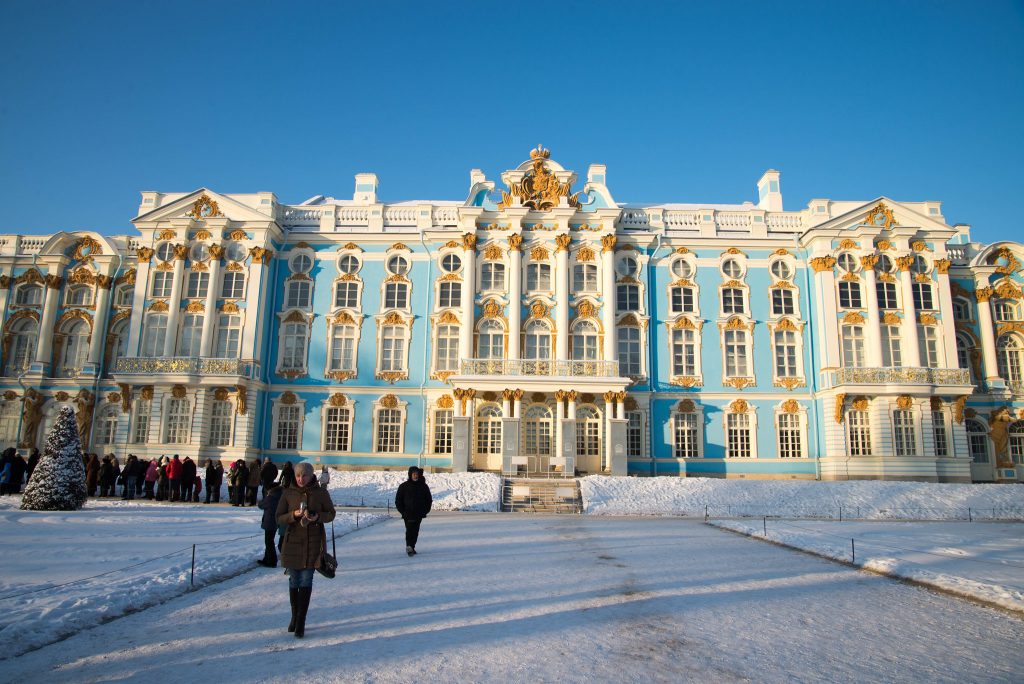
Frequently Asked Questions
Where is Catherine Castle Located?
Catherine Palace is located in Pushkin, 30 km (18.6 miles) south of Saint Petersburg, Russia.
When was Catherine Castle Built? Who Build It?
It was first built in 1723 by Johann Ferster. The architect behind the palace’s luxurious update was Johann Friedrich Braunstein.
When is The Best Time to Visit the Castle?
The best time to visit Catherine Palace is in the warm months between May and September.
What Other Monuments are Located Nearby?
Other monuments you can visit in the area include the Katherina II monument, Morea column, Monument to Rastrelli, or Monument to Alexander Pushkin.
FOR HISTORY | BEAUTIFUL IMAGES | INTERESTING FACTS | TRAVEL TIPS
Early History
Construction & Early Years (18th Century)
The land was endowed to Empress Catherine I by her husband Peter I; a castle was built on the site in 1723. It had two floors and a total of sixteen rooms, a garden in the southeastern area, along with an animal enclosure across from the main building.
After Catherine, the estate was inherited by her daughter Elizabeth, who designed another castle on the site in 1744. The property was expanded to span out to a length of 300 meters (328 yards) consisting of a central house, a chapel, side wings, halls, gardens, and galleries.
Renovation & Expansion (Mid-18th century)
Under Bartolomeo Rastrelli (1751)
In 1751, the castle was renovated with the inclusion of several more buildings, pillars, domes, and sculptures of gold. The walls were also repainted and accentuated with gilded stucco with the distinct colors seen today. This project was conducted by renowned architect Bartolomeo Rastrelli who followed a Baroque sensibility in his design.
Other artists who contributed to the renovation project included Leprince, Giuseppe Valeriani, and sculptor Franz Dunker. The rooms added during this renovation include the Chinese Room, embellished with panels of lacquer; the Light Gallery; the Portrait Hall; the red-hued Amber Room decorated with fine amber panels; five anterooms; and a Great Hall with an area of 860 meters square (9257 ft2). The different buildings built in this era were connected through specially designed hanging gardens.
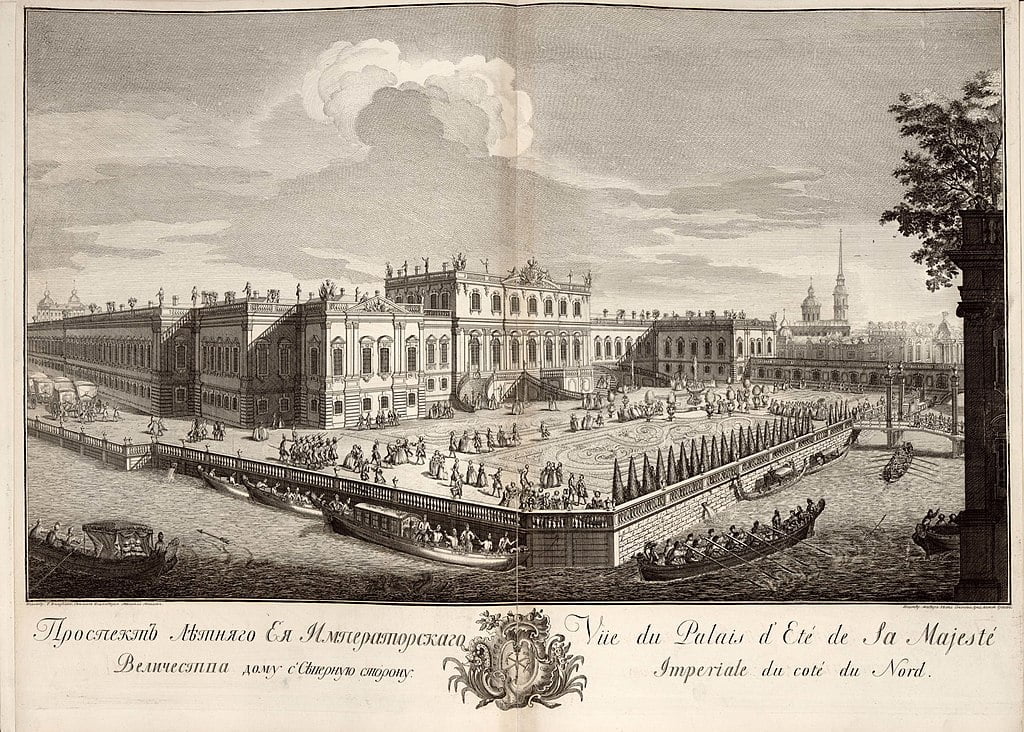
Gardens & Pavillions (1756-1760s)
By the time the reconstruction ended in 1756, the castle hosted 40 state apartments while the total number of private and service rooms in the estate exceeded a hundred. Another garden was also incorporated into the palace while the previous garden was enhanced by deepening the pond and connecting it to the beautiful springs located 6 km (3.7 miles) away from the estate. A hermitage, a toboggan slide, and pavilions known as the Island, Mon Bijou, and Grotto Pavilions were also added to the structure.
Vast Expansions (1770s)
In the late 18th century–between 1768 and 1771–Italian architect Rinaldi added two columns: the Chesme Column and the Morea Column, along with a monument known as the Kagul Obelisk in memory of the war between a Russian-led coalition and the Ottoman Empire in Turkey. Some edifices in Gothic style were added to the compound, including the Hermitage Kitchen, the Turkish Cascade, and the Admiralty.
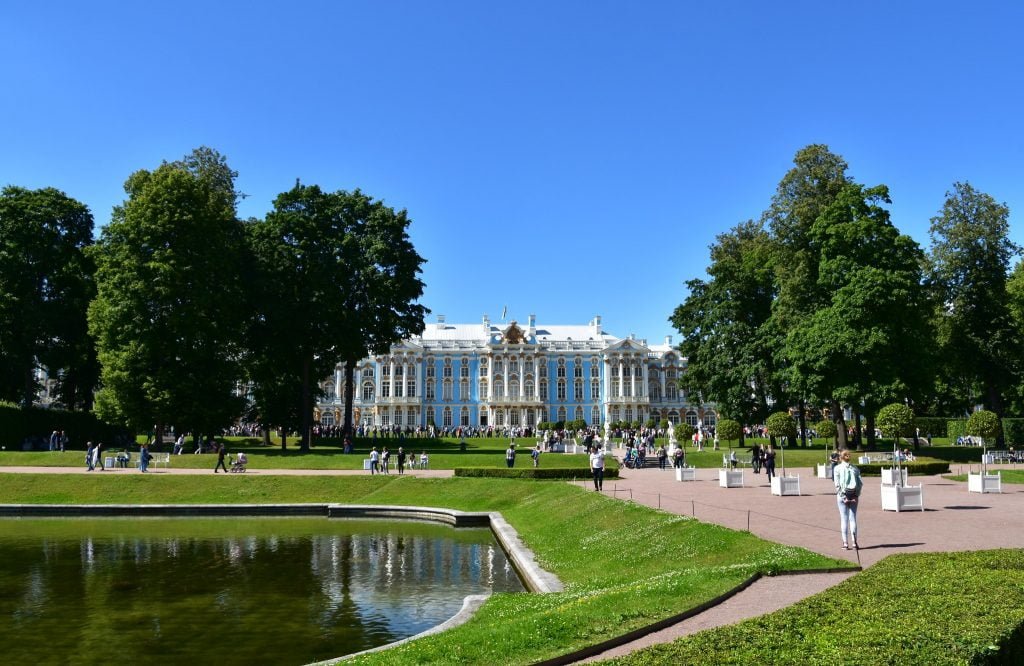
Some other designs incorporated into the castle include the Creaking Pagoda and the Great Caprice, both of which are symbolic Chinese patterns. The Upper and Lower Baths were constructed by Russian architect Neyolov in an Early Classic style. He also constructed the Opera House between 1778 and 1779. A music pavilion and Ceres’ Temple were constructed by architect Quarenghi. He also built a kitchen folly near the Concert Hall. By the late 18th century, Neyolov had constructed the Babolovo Palace on the site, while Quarenghi had established the Alexander Palace.
In the 1770s, the Baroque architecture of the castle was largely replaced by a Neoclassical style. This renovation was carried out by Yuri Velten, who redid the southern facade of the castle and converted one-story annexes to four-story annexes which we now know as the Zubov and Chapel Annexes.
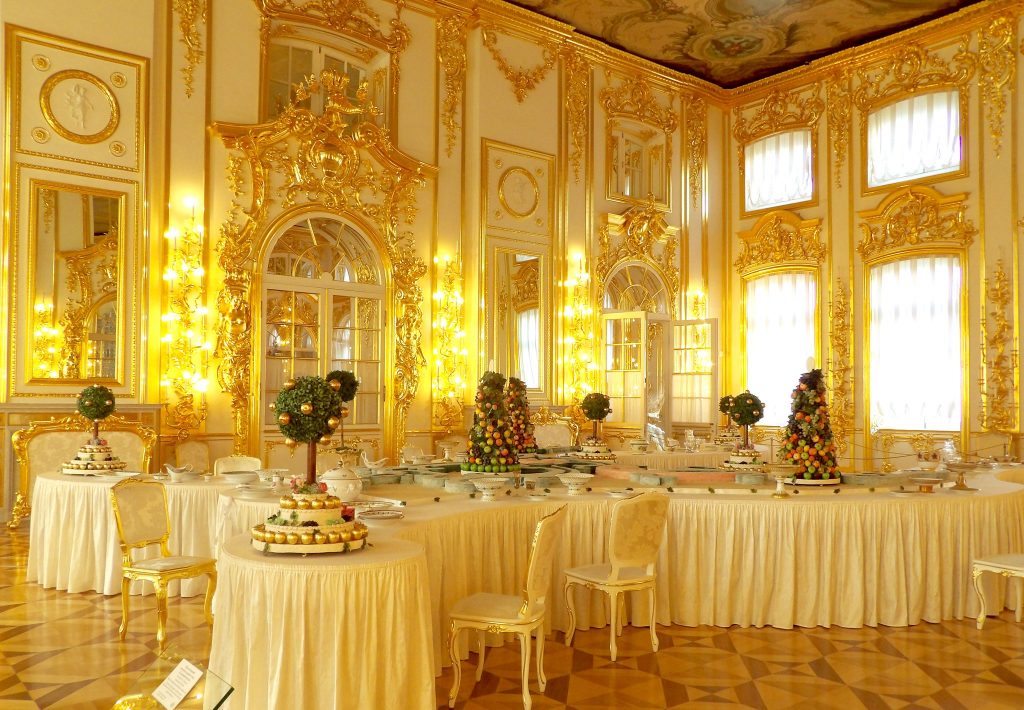
Interiors & More Expansions (1780s)
Service and private rooms were constructed in place of the main staircase of the castle, including an updated Chinese Room embellished with designs by Scottish architect Charles Cameron, while a new staircase was constructed in the center. Beyond that, French silk was used on the walls of Cameron’s Lyons Room while lapis lazuli was used to beautify the doors, panels, and stoves. The room belonging to the Empress herself was constructed in Wedgwood jasper bas-reliefs crafted by architects Stubbs and Flaxman. The room known as “Snuff-box” or The Blue Room was designed with bright white and blue glass upon the walls.
In the 1780s, the Arabesque Room–named for the styling of its entrance, ceiling, and walls–was added to the castle. Ancient designs from Greece and Rome were used to decorate the vertical panels on the walls. Other rooms constructed in the period included the Mirror and Silver Rooms, designed by Quarenghi in 1789.
Fire, War, and Later Years (Late 19th Century & Onwards)
The death of Catherine I in 1796 brought a pause to much of the renovation. There was a fire in 1820 during the French invasion, which resulted in the destruction of various structures including the chapel designed by Rastrelli and adjacent apartments. A restoration project for the structures was carried out by Vasily Stasov.
In the early 19th century, architect Luigi Rusca added the Granite Terrace to the estate. By 1817, the Triumphal Arch was built in the compound, by Stasov, to commemorate the Russian victory during the invasion of Russia by the French. Between the years 1851-52, the Turkish Bath was added to the complex by Monighetti.
In the mid-19th century, stucco ornaments and Hermitage Museum canvases were added to stateroom ceilings by Andrei Stakenschneider. The central stairway along with the main porch of the castle was renovated by Monighetti.
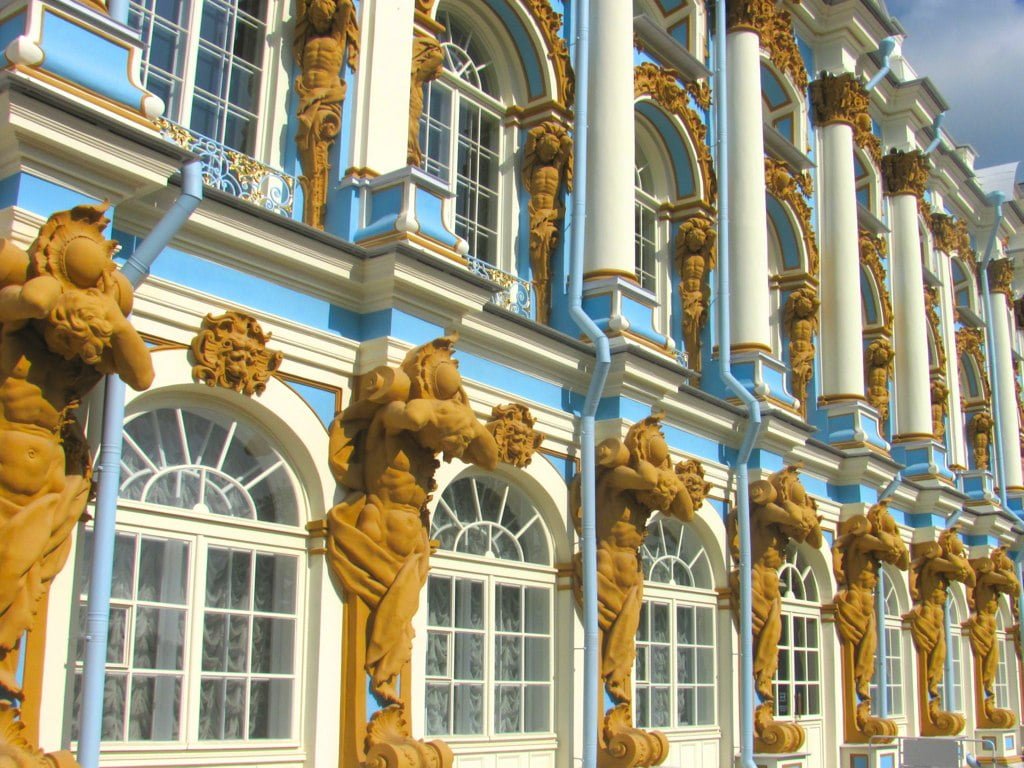
Revisit More Historic Places Below or Read Further
Current Times
In the Second World War, German forces destroyed much of the palace complex. Owing to good documentation of the pre-war interior by Soviet archivists, the palace was able to be reconstructed to a fair resemblance of the original in 1957, under the management of the State Control Commission for the Preservation of Monuments led by Alexander Kedrinsky. It has since been preserved as a national monument.
Currently, the castle and its vicinity are open for public access as a museum and are managed by World Heritage Site Saint Petersburg.
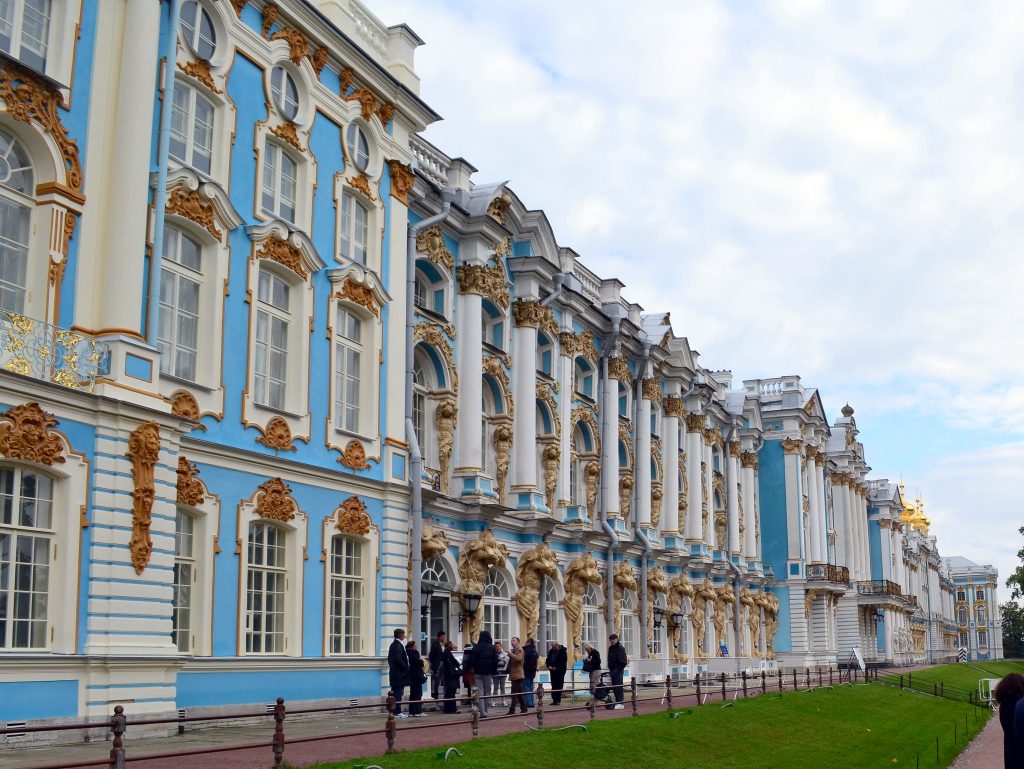
Interesting Catherine Castle Facts
- The castle was originally constructed as a summer residence for Russian emperors.
- Parts of the palace were destroyed in the Fire of Moscow in 1812 and had to be renovated.
- The reconstruction of the Amber Room inside the palace took 20 years and a budget worth $12 million!
- The White Formal Dining Hall contains a mural known as the Triumph of Apollo, which was copied from 16th-century Italian painter Guido Reni.
- The mural on the ceiling of the Courtiers-in-Attending Dining Room is based on ancient Greek mythological concepts including that of Helios, the sun god, and Eos, the goddess of sunrise.
- The Great Hall of the palace, formerly known as the Light Gallery, covers an area of about 1000 square meters (10763 ft2).
- A movie based on Catherine the Great which features Helen Mirren and Gina McKee was filmed in the palace.
Visiting Catherine Castle – Tips and Tricks
Catherine Palace is one of Russia’s crown jewels; if you’re a fan of Baroque or Classical architecture, then you definitely need to visit it. Here’s everything you need to know about planning your trip:
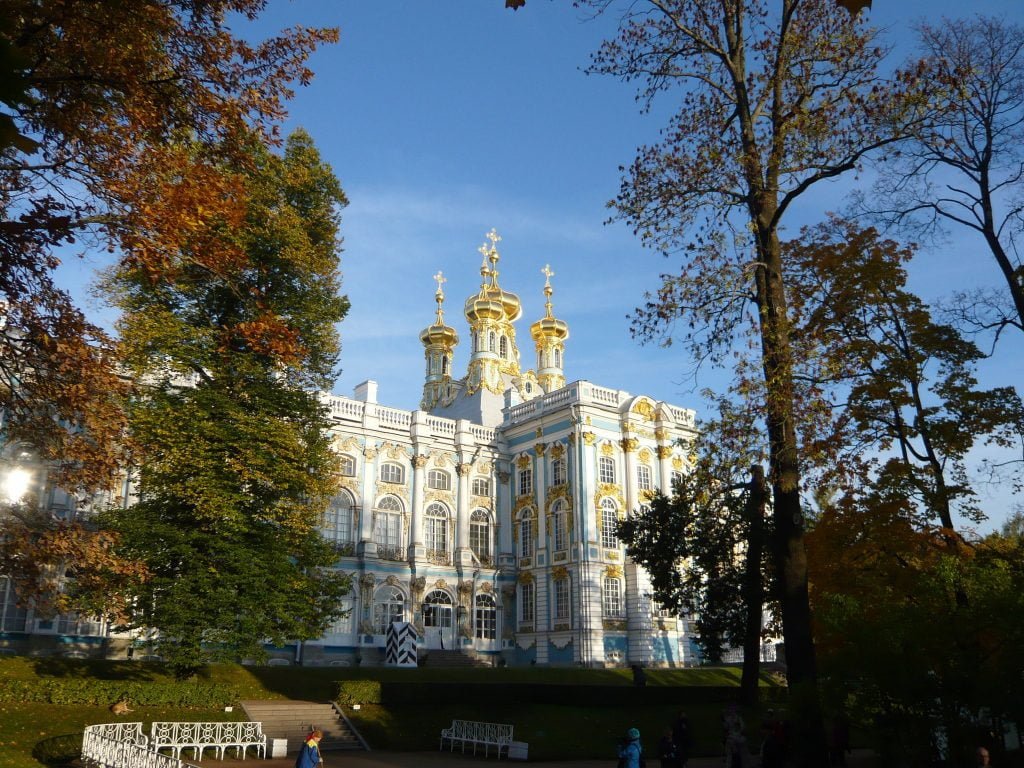
How to get to Catherine Castle?
Getting from Moscow Sheremetyevo Airport to Catherine Palace, Pushkin can be achieved by taking the night bus, the aero express, or via taxi.
The most recommended–as well as affordable–option, is that of the night bus. The bus leaves every 30 minutes from the airport and will drop you at Teatralnaya Ploshchad, a 43-minute ride from the airport. From Teatralnaya Ploshchad, you will take the subway from Ploshchad Revolyutsii station and get off at Baumanskaya. From that point, the castle is just a 25 to 28-minute walk away. This route will cost you around €2 ($2 USD) and take you a little over an hour and 20 minutes.
If you opt for the Aerobus, you would have to board the train, which leaves on an hourly basis, from the airport and get off at Okruzhanaya. At Okruzhanaya you will get aboard the train heading towards Rimskaya and get off at the location. From Rimskaya, the castle is a 25-minute walk. The whole journey will take you an hour and 35 minutes and cost you around €9 ($9 USD).
The third and fastest way to get there is via taxi. You can easily find one outside the airport and reach the site within 32-35 minutes. The journey should cost you around €3 to €5 ($3-$5 USD).
Ticket Prices, Visiting Hours & Travel Tips
Information was checked & updated on November 5, 2023.
During September to Mid-April, the castle is open daily from 7:00 pm to 9:00 pm. From Mid-April – July, the castle is accessible daily from7:00 pm to 11:00 pm and August 1–30 7:00 pm to 10:00 pm.
In wintertime, between the months of October through late April, the castle is open from 10:00 am to 5:00 pm from Wednesday to Sunday, and from 10:00 am to 8:00 pm on Mondays. Tuesdays, along with the last Monday of each month, the castle is closed. On national and school holidays, the timings are 12:00 pm to 8:00 pm on Mondays and 12:00 pm to 5:00 pm on other days. Other timings may be pre-arranged for organized groups.
Tickets can be purchased either online or from the two entrances to Catherine Park. Limited tickets are available on a daily basis and hence it is recommended to reach the site as early as possible. Admission tickets are free for children under the age of 16. For students with an ID and children over 16, the price is 400 rub ($ 4 USD). For adults, the price is 800 Rub ($9 USD) per head.
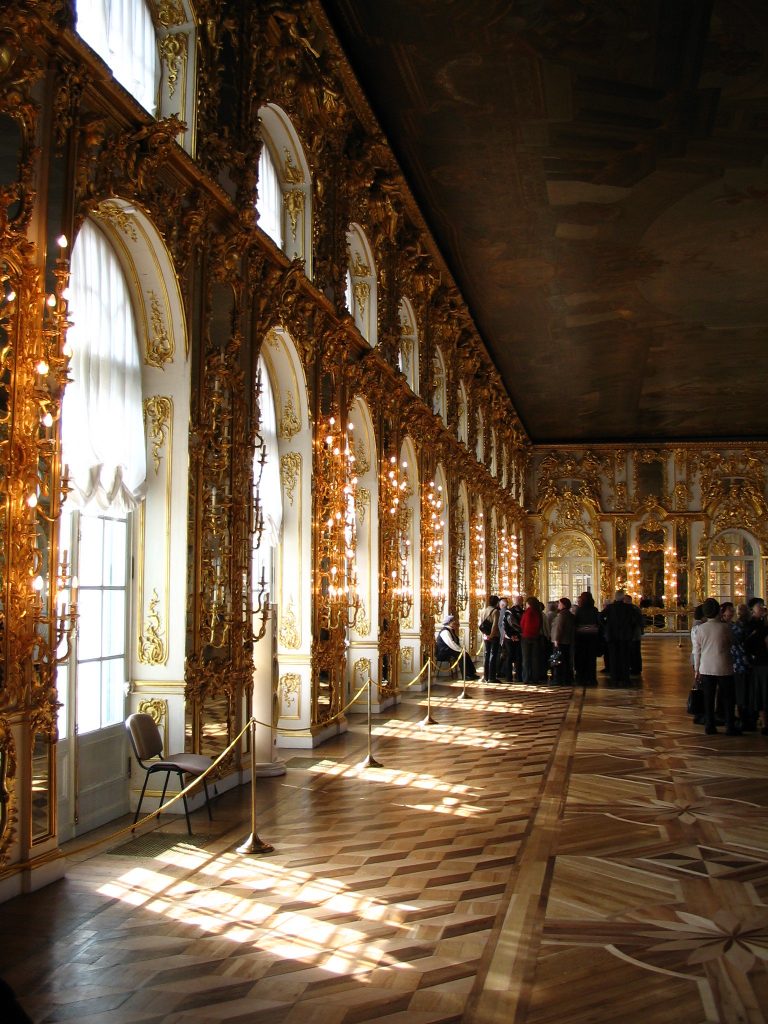
How Long Does it Take to Tour Around?
3 hours on-site, at the very least, is recommended to experience every mesmerizing facet of Catherine Palace to the fullest.
Up to Date Information
For up-to-date ticket prices and visiting hours visit the official website: https://www.tzar.ru/en
Some words of advice and tips:
- Keep track of concerts and event schedules from the official website to get a rich cultural experience.
- The castle is wheelchair friendly. A special elevator facility is available for wheelchair access; however, it is recommended to notify the staff in advance so that they can facilitate you properly.
- Guided tours in English may not be available unless booked in advance, so you may want to book one prior to your visit or else hire an interpreter.
- It is recommended to arrive early in order to keep a time margin for the ticketing queues, or purchase tickets online.
- The park outside the palace has great spots for taking memorable pictures!
- It is recommended to wear a mask but not mandatory.
- Very few of the plaques are in English, but you can use Google Lens to translate them for yourself.

